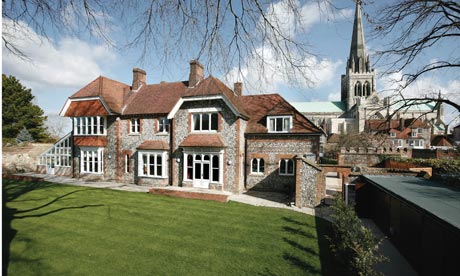
George Bell House was built in the late 1800s as a cathedral residency, and became home to the archdeacon of Chichester. Now it provides accommodation for visiting clergy, but also earns its keep as a B&B for paying guests who, like me, fancy a break tucked into a quiet cathedral close.
Formerly 4 Canon Lane, the house was dedicated in 2008 (by Rowan Williams) to the Rt Rev George Bell, patron of the arts, friend of the composer Gustav Holst and bishop of Chichester from 1929 until 1958. Bell spoke out against Nazism, but his opposition to the allied bombing of German towns and cities did not go down well in wartime Britain, and there is a view that had Bell not made himself unpopular in high places, he would have become archbishop of Canterbury.
I knock on a heavy wooden door and moments later I'm stepping into a double-height lobby. Bet those are Delft tiles, I think to myself, surveying a fireplace. A wide staircase with clover-leaf embellishment has a witty carved bishop's hat atop the newel post. Serious art on the walls fights with an acre of patterned carpet.
All signed in, I'm shown upstairs to my room, a generous if slightly bland, plum-coloured affair with cathedral view. There is tea, coffee and Scottish biscuits in a wooden box, flat-screen TV, plump pillows and satin cushions, a bedside Tiffany-style lamp (but no Gideon bible), and shower room with lemongrass soap, rowdy extractor and a yellow sticker that says "caution hot" – quite needlessly, since the towel rail is freezing cold. However, the only real irritations are a wall-mounted shelf with knick-knacks on it and a lack of information about this rather lovely house: instead of providing a history, the room folder claims there is room service (which turns out to be a future plan rather than current reality).
Downstairs in the rear sitting room, wing armchairs and sofas are arranged around the edges, retirement-home style, a solitary coffee table stranded in the centre. I'm being mean – the atmosphere and outlook on to the deanery and a walled garden are peaceful. What the decor lacks the lighting makes up for and bookshelves bear Primo Levi to William Dalrymple, The Da Vinci Code and religious texts.
Rain sets in, obscuring the bishop's palace gardens from my bedroom window but lending a blurry glow to the cathedral illuminations. Forgive the expression – but it's one hell of a view.
Breakfast (perfect scrambled eggs and buttery grilled tomatoes) is in a cheery red room that opens on to the garden. The good news is, someone has contacted Richard Meynell, the project architect of the cathedral close, who whizzes in at short notice. The building has elements of previously demolished houses, he says. The lobby fireplace is Tudor, and yes, the tiles are Delft. Medieval porch tiles came from the cathedral retrochoir, a jewel-patterned plasterwork ceiling reflects ecclesiastical vestments, and further fireplaces are Italian marble.
"It's almost decadent, isn't it?" he says, before rushing off. Now I'm hurrying, to meet Alan Bradford, a volunteer guide, who sweeps me around the cathedral, via Chagall stained glass and Tudor panels, on a tide of historic tales and controversial arts patronage. Oh, and paintings in George Bell House are lent by Pallant House Gallery, second only to the Tate for modern British art, Alan tells me, before we part.
It all makes me wish they'd taken some risks with the decor at George Bell House, but when you add in the location, helpful staff and calibre of the cathedral tour – it's a win-win.
• For more information, see visitsussex.org

